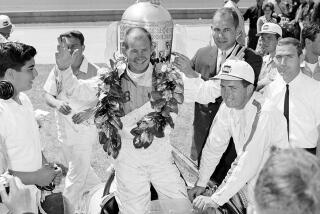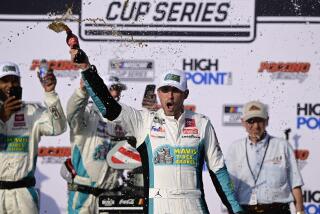The NASCAR speed trap
- Share via
LONG POND, PA. — In a sport that basically stretches from Valentine’s Day to Thanksgiving, there’s always something to talk about.
As the NASCAR Sprint Cup series returned to Pocono Raceway this week for the second of two annual events here -- this one officially called the Sunoco Red Cross Pennsylvania 500 -- a new talking point emerged. And it one that many people can relate to because they have been guilty of it at least once -- getting a speeding ticket.
This topic became front and center after Juan Pablo Montoya was penalized for speeding on pit road at the Brickyard 400 at Indianapolis last week.
Montoya had led 116 of the 160 laps and was leading the race by five seconds at the time of the infraction, but he was forced to pass through pit road again and fell to 12th. Jimmie Johnson went on to win his second straight Brickyard race.
The speed limit in the pits is 55 mph, but like many of our friends who drive cars with red lights on top, there’s a little bit of a cushion -- five mph in this case.
There are eight timed zones, and Montoya was caught going 60.06 and 60.11 in two of them.
You could almost hear him say, “But officer, I was just six-hundredths of a second over the limit.”
Montoya said much more than that on his car radio: “Thank you, NASCAR, for screwing my day. We had it in the bag and they screwed us because I was not speeding.”
He was much calmer at his pre-Pocono news conference Friday, saying, “For some reason, they said we were speeding and that’s what it is. I’ve moved on and that’s it. . . . Whether you’re right or wrong or they’re right or wrong, today we can’t change it.”
But it will be an area of interest at today’s race because pit road at Pocono is the longest of any on the Sprint Cup circuit and could be the most crucial place on the track considering that passing on the “Tricky Triangle” is generally minimal.
When Montoya was caught, many suspected conspiracy; others attributed it to stupidity.
Either way, you can bet everybody will be keeping a closer watch on their speed as they stop in front of the big grandstand.
But it’s not as easy as checking speedometer. The technology isn’t as state-of-the-art as you’d think.
“In every other form of motor sports, you come to pit road and hit a button and it regulates the rpm and the mph and you just sit there at that rpm,” Jeff Gordon said. “I don’t understand why we don’t have that with all of the technology we have at our fingertips. But we’ve gotten our tachs at lot better and we’re able to read it pretty close.”
In Montoya’s case, it wasn’t close enough.
Mark Martin was sympathetic.
“It’s just devastating when you have one of the races of your life slip through your fingers,” he said. “I don’t blame [Montoya] for being upset.”
In this era of NASCAR the cars are generally very close in technical capability. That means any edge is important. Drivers look to pit road as one place where they can gain an advantage.
“It’s tough because we can’t pass on the racetrack, so we’re trying to go as fast as we can on pit road,” Kurt Busch said. “But it’s not worth it. Montoya had a five-second lead when he hit pit road. There’s no sense pushing it that close if you have that big of a cushion on the track.
“I’ve been caught speeding hundreds of times and never got asked about it,” he said. “I don’t know why it’s such a big issue right now for some other guy.”
--
More to Read
Go beyond the scoreboard
Get the latest on L.A.'s teams in the daily Sports Report newsletter.
You may occasionally receive promotional content from the Los Angeles Times.










